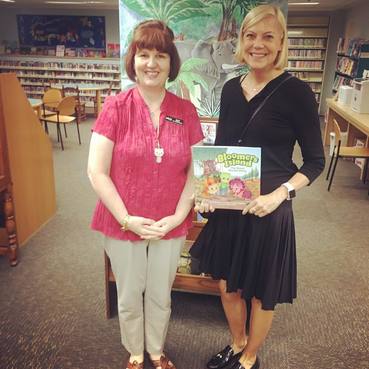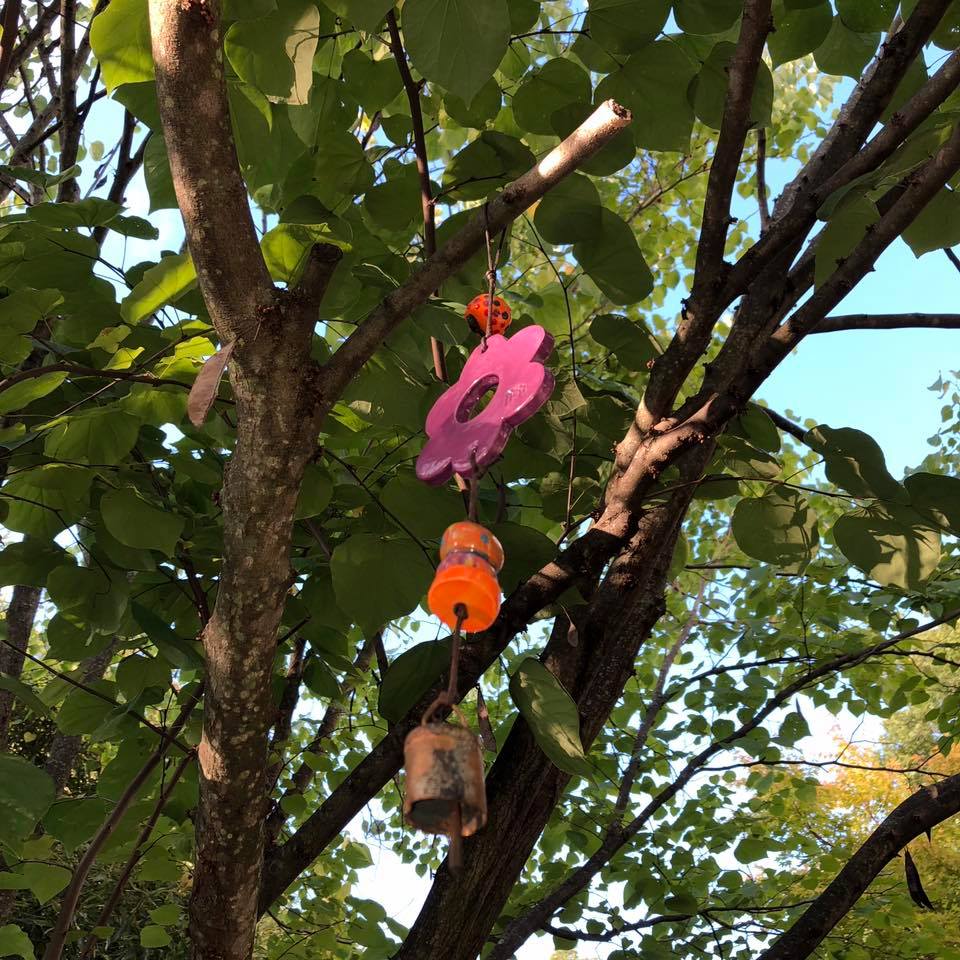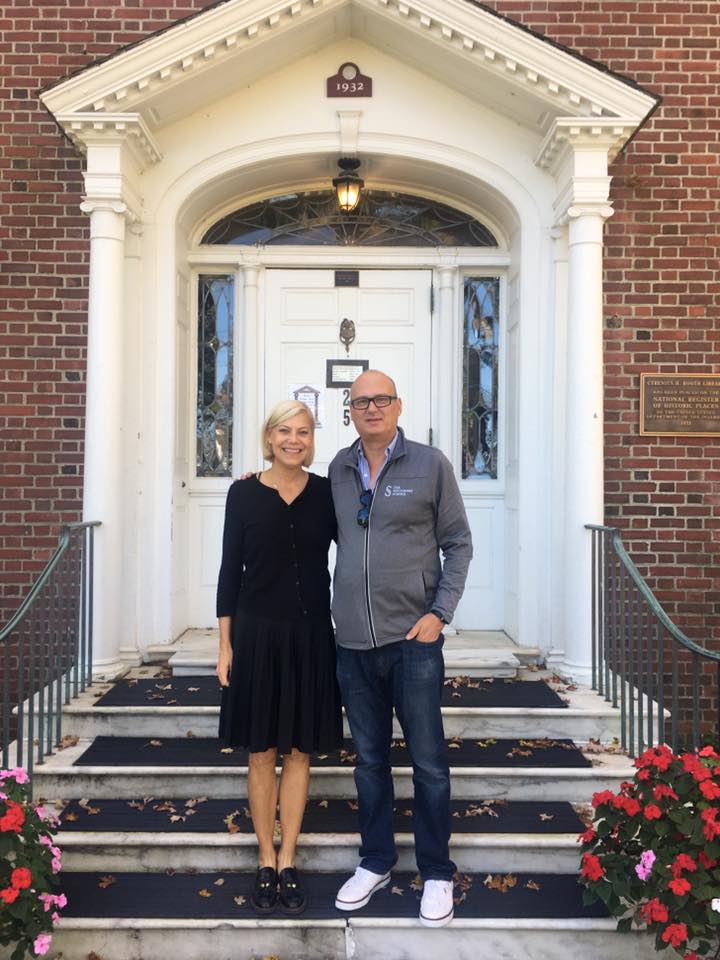|
Today we went to Newtown and for me, it was the first time. I’ve done a lot of firsts and gone to a lot of places for the first time during my 100,001 Book Tour. Dennis had a meeting at the Cyrenius H. Booth Public Library. I was along for the ride, as he is so often with me. I planned to donate a book to the library. That’s not out of the ordinary, because I have done it with many libraries touring around the USA this year. Newtown is a Norman Rockwell town. Yet, a pall had been cast — no fault of the residents, but nevertheless one that they had to contend with for the rest of their lives. You would think that a town where an unspeakable horror happened would be shadowy and foreboding and unwelcoming with cheerless streets. Not so. Like much of Connecticut, I found myself marveling over the perfect porches on the perfect homes on the perfect streets as we drove into town. Pumpkins sat next to cornstalks on the front stoops. Fall leaves lay on the grass lawns patiently waiting to be raked. I compared it to the messy streets of my hometown of Los Angeles with its gum-stained sidewalks strewn with tell-tale signs of the homeless interspersed with street art, cigarette butts and food wrappers, the detritus of streets well-lived in or on, as it were, but at least in L.A. what you see is what you get. We went to the library and had our meeting in a private room made available to Newtown residents. It was 12:30 when we finished so we agreed to meet at a local coffee shop to have a coffee and a bite to eat. On the way out, I signed and donated my first book, “Bloomers Island The Great Garden Party,” to the library, and we made a big deal out of it as I took a photo with the librarian downstairs in the children’s book area, surrounded by the innocence of, “Goodnight Moon,” and “Oh The Places You’ll Go,” and “Where The Wild Things Are.” My book would be in good company. I was grateful for that.  Leaving the building, which is on the National Register of Historic Places, like so many old buildings in Connecticut, Dennis dropped his backpack on the crunchy leaves and we snapped a photo of us on the front steps before driving off. In the safety of our car, I mentioned that every house we passed caused me to think, maybe a child was lost there and a child lost there and a child lost there? We were both thinking that in the quiet of the car ride. I was reminded of my mom’s long-term partner, Ed, whose son had died in a bicycle accident as a young boy. His wife had passed away from early onset Alzheimer’s, and he was diagnosed with it, too, also at a relatively young age. I always thought that maybe they had just checked out mentally. Life had become too painful for them and so they moved on. Who could blame them? The folks who had lost their precious children at Sandy Hook Elementary School, were irretrievably changed and their lives permanently altered as well and there was no coming back from that. These thoughts ran through my mind as I looked out the window at the beautiful Connecticut countryside. I have a confession. Although Ed was a wonderful guy who loved my mom deeply, I started resenting him. I felt like his deteriorating condition was too burdensome on my mom. She was somewhat frail herself and she had to do everything for him: drive him to all his appointments, make sure he took his medicine, make all his meals and clean up after him. He couldn’t do anything for himself anymore, not even get dressed in the morning. It was a slow, sad, form of decline, and during our prior visit, we had helped her make plans for him to leave. After arriving to the coffee shop, we sat down with our soy lattes and Caprese sandwiches and the man who we had met for our original meeting sat down next to me. His name is David, a handsome young guy with close-cropped hair, piercing eyes and full lips. He told me that he was married and had two young children. He wanted to remind me that a tragedy had happened in the town. Did I remember? I admitted that I was well aware. He told me that he was in town when the shooter had driven through on his way to Sandy Hook Elementary School. He remembered him because he ran a red light — so intent was he on his murderous mission — and no one ever ran a red light in Newtown. A short while later, this young father was with a group of friends in nearby Danbury when the word started coming out. There were whispers, like the swirling leaves in the Autumn wind. Did you hear what happened? Did you hear about that school? The school in Newtown? Sandy Hook? David confided that thankfully his child was not in school yet, a year too young at age four, but he knew many of the children in the small community. He also told me that there was a tremendous outpouring of love and help and healing that descended upon the town thereafter. He was concerned that not much was said about it. The media didn’t report it. He told me an example of someone who gave $5,000 to a local restaurant and anyone who came in had their meal paid for. Surely I had heard about Ben’s Bells? I had not. It was an organization started by a woman from Tucson, Arizona who had lost her own son many years before. Its mission was to spread intentional kindness in a community. She came into Newtown and many of the townsfolk made bells out of clay and string and brass and hung them on trees, hidden in plain sight. The idea was whoever found one would take it and keep it, and it would represent good luck, a memory, a kindness, an angel.  He had gone with his family and they too had made bells, placed them around the town, a process of grieving, of letting go. Our friend Amy, the fourth in our little meeting said that one day, David found a bell hanging on a tree. He then dug into his pocket and pulled out a bell strung with colorful ceramic balls, twine and in the middle was a pink flower cut out of clay and fired hard and bright in a kiln. He handed it to me. “Here. Now you have found one.” David then stood up and announced that he had to go. Our meeting had taken longer than he had expected. We left shortly thereafter, but many miles down the road we had to turn back around and return to Newtown. It would be my second time. Dennis realized he had left his backpack on the lawn in front of the library when we had stopped to take pictures. His wallet was inside. I called the library to see if it was still there. It had been over an hour since he had accidentally left it there, and the librarian said that no one had moved it. They just made a note of it at the front desk: “Backpack left on the lawn at 12:15.” They did not pick it up. No one had touched it. No one from the library. No passersby. The country’s safest town, I thought with great irony. It was also a town on the mend, a town being healed by a brand new school and bells and angels. There is a celebration of lives, of light that outshines the darkness. Survivors wanted to talk about it. We later told each other about the profound affect and change the visit to Newtown had on us. Dennis’ change was a commitment to speak about the children to other children in an upcoming project. They cannot be forgotten. And my change? I would have more empathy for loss. I would come back to visit, to work with the schools in Newtown. There is healing in planting a seed and watching it grow. That is something I could pass along.
1 Comment
I am an original founder of a mastermind group started over a decade ago. The idea is to apply business principles to our personal lives. I noticed that a lot of people don’t know how to properly construct and use business principles — things like vision strategies, legacy statements, marketing plans and financial projections — things that would really help them in their personal lives. Our mastermind group consists of five women (some have come and gone but it consistently remains five) who meet once a month and hold each other accountable as we work our way through our life planning. Part of this blog post is excerpted from the exercises that we are documenting.
One of my favorite exercises we have done is a standard business application called a S.W.O.T. analysis. It is an acronym for Strengths, Weaknesses, Opportunities and Threats. The formula I came up with to do a SWOT analysis is to first, decide what you want to achieve or evaluate, and then break your analysis down into two basic categories. 1. Evaluate the opportunities and threats that exist for what you want to achieve. Think of these as external factors. 2. Honestly assess your strengths and weaknesses. Think of these as internal factors. The difference between the two categories, internal and external is huge because you can personally work on internal issues in order to improve. External issues are harder because you can’t change them. For that reason they are often the cause of worry which is fruitless and the nemesis of many of us. However, you can leverage external situations to your advantage or hedge against them to protect yourself. Remember to start with what you want to achieve. My present goal is to sell 100,001 books in one year’s time. Opportunities and Threats What are my opportunities? I am with a major publishing house. My books are good. I know this because I read it to children all the time. They are engaged. It is being sold at almost all the major booksellers, and if they don’t have it in stock, they can easily order it. Penguin Random House has an entire structure set up for these types of logistics. Other products I’ve invented, such as my Bloomers Island VeggiePOPS and Growing Kits are currently being sold in major retailers. I can leverage my relationships there. I can employ these things to my advantage. On my website and in all my sales sheets and brochures, I make sure that I mention Random House Children’s Books because it gives me legitimacy, after all they are the number one publisher in the world, for which I’m humbly grateful to be a part of. My licensee is calling on our current retailers and pitching them on including a book with one of our VeggiePOPS. What are my threats? The economy can crash. Booksellers can and do go out of business. People read less books now. They buy eBooks which are cheaper and don’t make as much money. How can I hedge against these threats? Help booksellers increase their sales with things like my influencer’s shop, Bloomers Island, on Amazon, and school events done in conjunction with book stores. Package the book with existing products that I am already selling in major retailers to substantially increase sales. These are just some examples. There is a lot I can do to both leverage and hedge. One of my esteemed advisors, John Michael Morris, used to tell me to make a list of twenty things whenever I was confronted with a worrisome or uncertain issue. I listed twenty ways I could protect myself and exploit opportunities to reach my goal. You might think coming up with twenty things is hard, but once you get started, it’s easier than you think. Start with five. You’ll get to twenty. Use your most powerful weapon, your brain. It also forces you to dig deeper (pun intended), and get really creative with solutions. You can do it. Your Homework: Come up with your threats and opportunities related to your goal, and then twenty ways you can take advantage of the opportunities and protect yourself against the threats. Please share your methodology and your list and next week I’ll tackle strengths and weaknesses. Happy digging. |
All images and designs copyright © 2008-2020 Cynthia Wylie. All Rights Reserved. Contact for licensing opportunities.




 RSS Feed
RSS Feed








